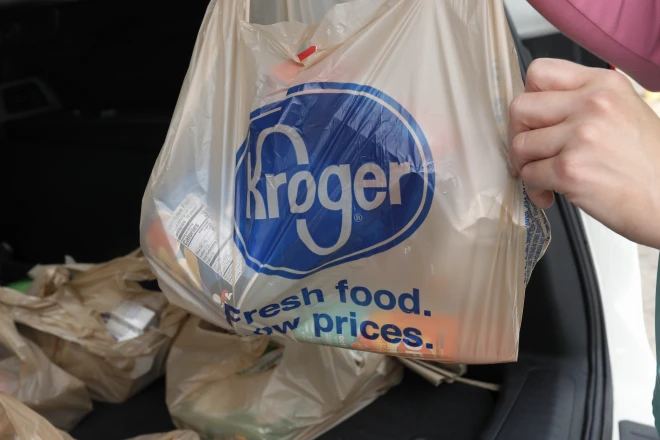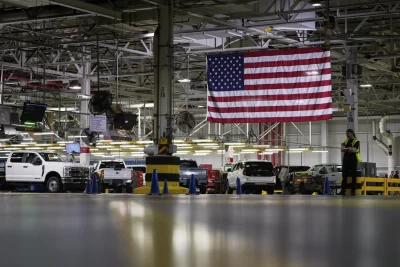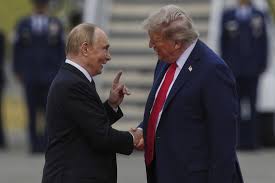
Kroger and Albertsons — two of the biggest grocery chains in the United States — had hoped to complete the largest supermarket merger in the country’s history this year. But their plan to compete with big-box retailers by combining forces faces legal challenges that make it look far less likely, at least any time soon.
On Monday, the U.S. Federal Trade Commission filed an administrative complaint against Kroger’s $24.6 billion deal to acquire Albertsons and a federal lawsuit that asks a judge to block the merger for now. Attorneys general from eight states and the District of Columbia joined the lawsuit lodged in Oregon.
Here’s what to know about the proposed merger, what it might mean for shoppers — and why the U.S. government opposes it.
Most Americans have filled a basket at an Albertsons or a Kroger store even if the sign out front had a different name. Kroger, based in Cincinnati, Ohio, operates 2,750 stores in 35 states and the District of Columbia. The company’s 19 brands include Ralphs, Smith’s, King Soopers, Fred Meyer, Food 4 Less, Mariano’s, Pick ’n Save and Harris Teeter. Albertsons, based in Boise, Idaho, operates 2,273 stores in 34 states. Its 15 brands include Safeway, Jewel Osco, Vons, Acme and Shaw’s. Together, Kroger and Albertsons employ around 700,000 people.
Why does the proposed merger matter?
Cities where Kroger-owned and Albertsons-owned stores now vie for customers include Los Angeles, Seattle, Portland, Denver, Phoenix, Dallas, Chicago and the District of Columbia.
What would THE Kroger-Albertsons merger mean for consumers?
Some labor unions and consumer advocacy groups predict the merger would result in store closures, leaving communities with fewer grocery options and giving Kroger-Albertsons fewer incentives to keep prices down.
“A merger of Kroger and Albertsons would dramatically decrease competition within an already consolidated food retail market, which would result in fewer grocery stores and higher food prices, with predictable adverse consequences for food and nutrition security for consumers across the country,” Peter Lurie, president of the Center for Science in the Public Interest, said in a statement applauding the FTC’s action.
Kroger says no stores would close as a result of the merger. It also promises to invest $1.3 billion to update Albertsons’ existing outlets. But in some places, stores would get sold to a new owner. To stave off monopoly concerns from federal regulators, Kroger and Albertsons agreed to sell 413 stores and eight distribution centers in locations where their operations overlap.
The buyer would be C&S Wholesale Grocers, a grocery supplier that also owns the Piggly Wiggly brand. But the FTC says the divestiture deal is “inadequate” and the proposal doesn’t contain enough stores or other resources to replicate the competition that currently exists between Albertsons and Kroger.
Why do Kroger and Albertsons want to merge?
Kroger and Albertsons agreed to merge in October 2022. The companies said a merger would help them better compete with big retailers like Walmart, Costco and Amazon, which owns Whole Foods, because they would have more power to negotiate prices and could save on distribution and administrative costs. Together, they would control around 13% of the U.S. grocery market; Walmart now controls 22%, while Costco controls 6%, according to J.P. Morgan analyst Ken Goldman.
Why does the Federal Trade Commission oppose the merger?
The FTC says the deal would eliminate the competition that now exists between Kroger and Albertsons, and without competition, buyers would see higher prices, lower quality and fewer shopping choices. In a separate lawsuit filed earlier this month, Colorado’s attorney general gave a specific example. The city of Gunnison, Colorado, has two groceries: Kroger-owned City Market and Albertsons-owned Safeway. The merger would make Kroger the only chain operating in this area, and a Gunnison resident would have to drive 65 miles to a non-Kroger store.
Consumers also would see fewer deals if the stores merged since Kroger and Albertsons currently use promotions to lure shoppers away from the competition, according to the FTC. The agency also foresees less incentive for stores to add or improve services. When Albertsons executives saw unstaffed deli counters at Kroger’s Fred Meyer stores, for example, they added counter staff at their stores. In the same way, Kroger improved its grocery pickup services in some markets to compete with Albertsons.
The FTC says competition at supermarket pharmacy counters also benefits consumers. When Kroger went out-of-network with a major pharmacy benefits administrator last year, for example, Albertsons offered consumers a $75 grocery coupon to transfer their prescriptions.
Would a Kroger and Albertsons definitely result in higher prices?
Kroger says it wouldn’t, and that it would invest $500 million to lower prices across its stores once the deal goes into effect. GlobalData, a market research firm, said discount chains like Aldi and cost-conscious competitors like Walmart would help keep prices in check even if Kroger and Albertsons combined.
But the FTC isn’t convinced. In a 2012 study, FTC economists found that prices increased more than 2% when grocers merged in places where they had little competition. Prices only decreased or stayed the same in markets where grocers had more competitors.
What would happen to the workers?
Kroger promised to boost wages and benefits by $1 billion if the deal goes through. C&S Wholesale Grocers said it would honor all collective bargaining agreements with Kroger and Albertsons workers if it takes over QFC, Mariano’s, Carrs and other stores.
The United Food and Commercial Workers Union, which represents most workers at both companies, voted last year to oppose the merger, saying the companies hadn’t been transparent about how it would impact workers. Not all workers are opposed to the deal, however. UFCW Local 555, which represents grocery workers in Oregon and Idaho, said earlier this month that it supports the Kroger and Albertsons merger because it trusts C&S to operate the stores in its area.







